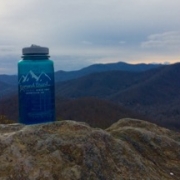Are you longing for April days when all the spring annuals are popping up all around? That is a fantastic time to enjoy the southern Appalachian Mountains; the warm sun is out and all the leaves are budding once again. However, you might be surprised at how many plants are growing in winter! Dozens of winter annuals are thriving right now. I recently went on a hike, only 15 miles outside of Asheville, known as Lookout Mountain. Along the way, I noticed some little green plants poking out of the ground, in defiance of all the brown and grey that winter brings. When the winter blues hit, and the lack of motivation is strong, bundling up and seeing what plants are growing seems to warm my spirit and lead to an enjoyable time outdoors.
Here are a few of the plants I noticed along my hike:
- When I started on the trail I was immersed in a dense tunnel of Rhododendron trees, Rhododendron maximum, which are definitely a staple of this region. Perhaps you notice that the Rhodo leaves are curled inside – as if they too are cold! Well, you aren’t too far off. While the Rhododendron is an evergreen, it is not immune from the winter chills. The Rhodo leaves curl to protect themselves from dehydration.
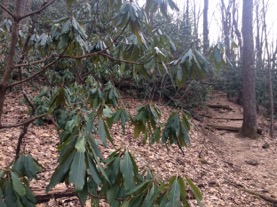
Rhododendron maximum
- Under the Rhodo understory I spotted a fern with a name that makes it easy to remember it’s alive during winter: the Christmas Fern, Polystichum acrostichoides. This evergreen fern adds a lot of green to the winter landscape. As this fern continues through winter, try turning the leaf over- maybe you will begin to notice the tips of the fern are becoming brown- that’s a fertile fern frond you got there! Once the Christmas fern has pollinated, the tip of the fern which had the spores will die away and fall off.
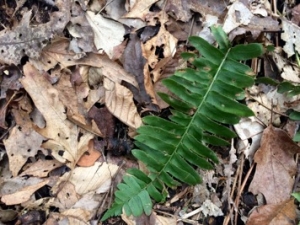
Christmas Fern
- Once the canopy opened up a little bit more I started to notice more greenery along the path. I was pleasantly surprised to spot my favorite winter plant, the Cranefly orchid, Tipularia discolor, This plant produces a single leaf in the late fall that persists through winter. The leaf is smooth and typically appears green on top with purple underneath. This plant is found in shade-tolerant places in moist and rich soil. The Cranefly orchid flowers in the summer and looks something like this.
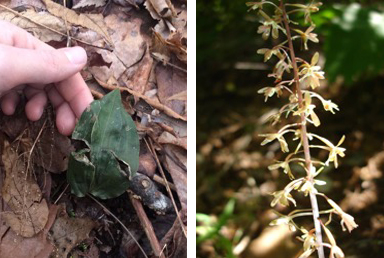
The Cranefly in winter (L) and in summer (R)
- As the trail continued to get steeper I noticed a little plant poking out from a mossy area. This leaf pattern features a white stripe down the middle with a mosaic pattern that might remind you of a critter equally as pattered, for this plant is the Rattlesnake Plantain, Goodyera pubescens. This evergreen orchid can be spotted alone as a single rosette or in a cluster of many rosettes. This little orchid is seen in groups because of its Rhizonomis reproductive structure, that is to say that underground all those little orchids are connected through the roots and the offshoots are genetically identical.
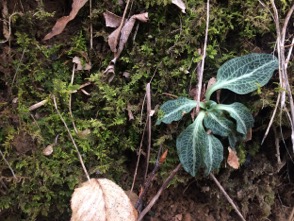
Rattlesnake Plant
- Another plant frequently recognized either by its extremely circular or heart-shaped leaf or, after a rainstorm, by its smell is the Galax Galax. While this plant may appear dense along the trail it is actually being overharvested. The Galax is being over-plucked by poachers who are selling the plant for ornamental purposes. So before you think about pulling it up and hanging it along your mantel, why not appreciate it outdoors instead! This plant was fun to spot along the trail. As I continued to the top of the hike I noticed the change in color of these leaves. The Galax earlier on the trail, at lower elevation, more covered by taller trees was fairly green. As the hike went on, the leaves started having spots of purply red. Once I had gained about 700 ft elevation, almost to the top, the leaves looked completely reddish-purple. Galax turns this color as a way of conserving sunlight. Once the Galax has received more sunlight than it needs, then the leaves turn the red and purple color. Sometimes this leaf smells like a skunk due to volatile compounds in the plant.
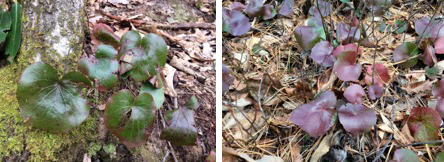
See the change in the Galax? The first picture was taken earlier on the trail at lower elevation, the second picture was taken towards the top at higher elevation & where the Galax was exposed to more sunlight
- Another plant that grows commonly around here and in dense sheets, you might not even notice it, it’s Chickweed, Stellaria media. This winter annual leaves are opposite, as opposed to alternate. The stems are slightly hairy, and in the spring this plant will feature 5 cleft petals, resembling 10 petals; think of cleft petals as hooves.
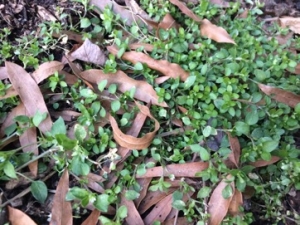
Chickweed
- The last plant is from another hike I took recently. This plant adds a nice warm brown as a winter stalk to the landscape. Most notably known for its large head of tiny yellow flowers in the late summer and early fall, it’s the Goldenrod, Solidago. This plant reminds me of a small furry gnome hat with the feathery seeds dispersed when you blow really hard similar to a dandelion. This winter stalk is one of my favorites to spot.

Goldenrod
I hope you are able to see some of these plants along your next winter hike! If you are curious about what else you are seeing out there try picking up a local flower guide. Try taking pictures of what you see or better yet sketch a plant in a small field journal. You don’t have to be an artist to sketch; for me it brings me joy and helps me stop for a minute, slow down and appreciate the plant.
Minimize your impact and maximize your enjoyment: Make sure you walk only on the trail! Your boots can track invasives on them from previous hikes and imagine what those plant seeds can do if you step off trail! Additionally, if enough people take short cuts or create new trails it can create erosion and could result in someone getting lost in woods. A tip to help keep others on the trail is to lay down some sticks across the path of an unintended trail. That way other visitors know not to walk down that trail as well!
See you outside,
Sarah
References:
https://www.bhg.com/gardening/trees-shrubs-vines/shrubs/why-are-the-leaves-on-my-rhododendron-rolling-up-and-wilting/
http://www.montreatlandcare.org/project/galax-protection/
https://www.fs.fed.us/wildflowers/plant-of-the-week/tipularia_discolor.shtml


